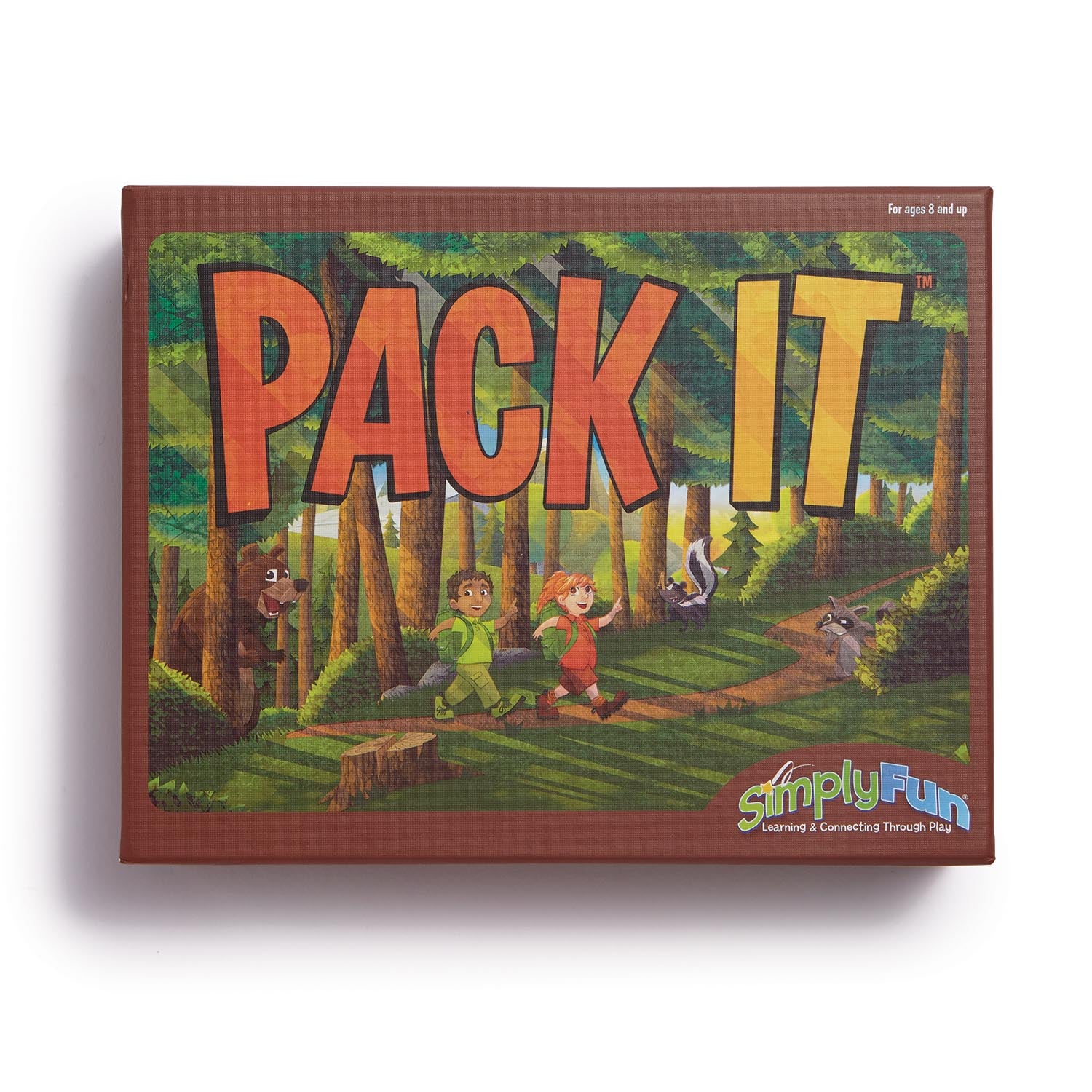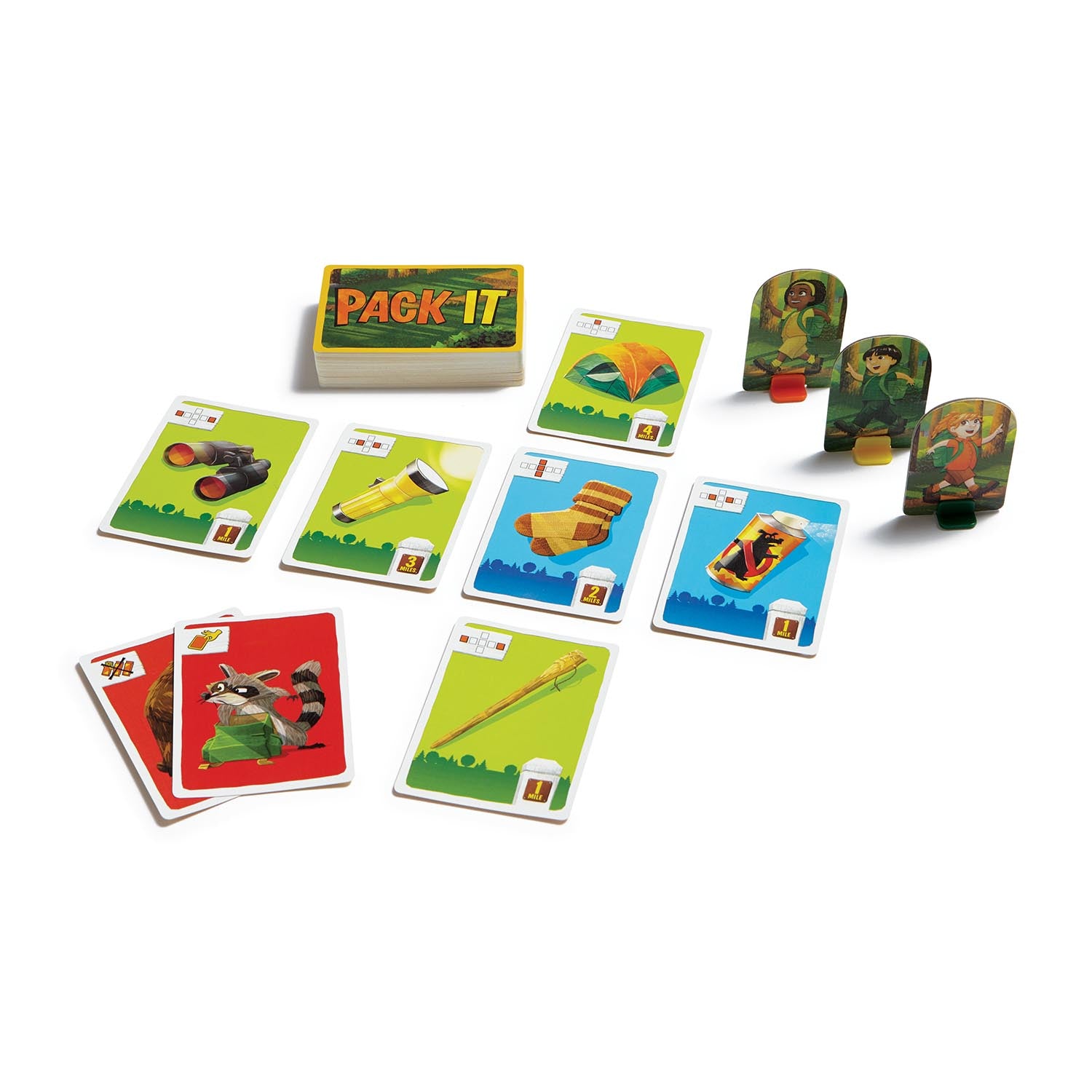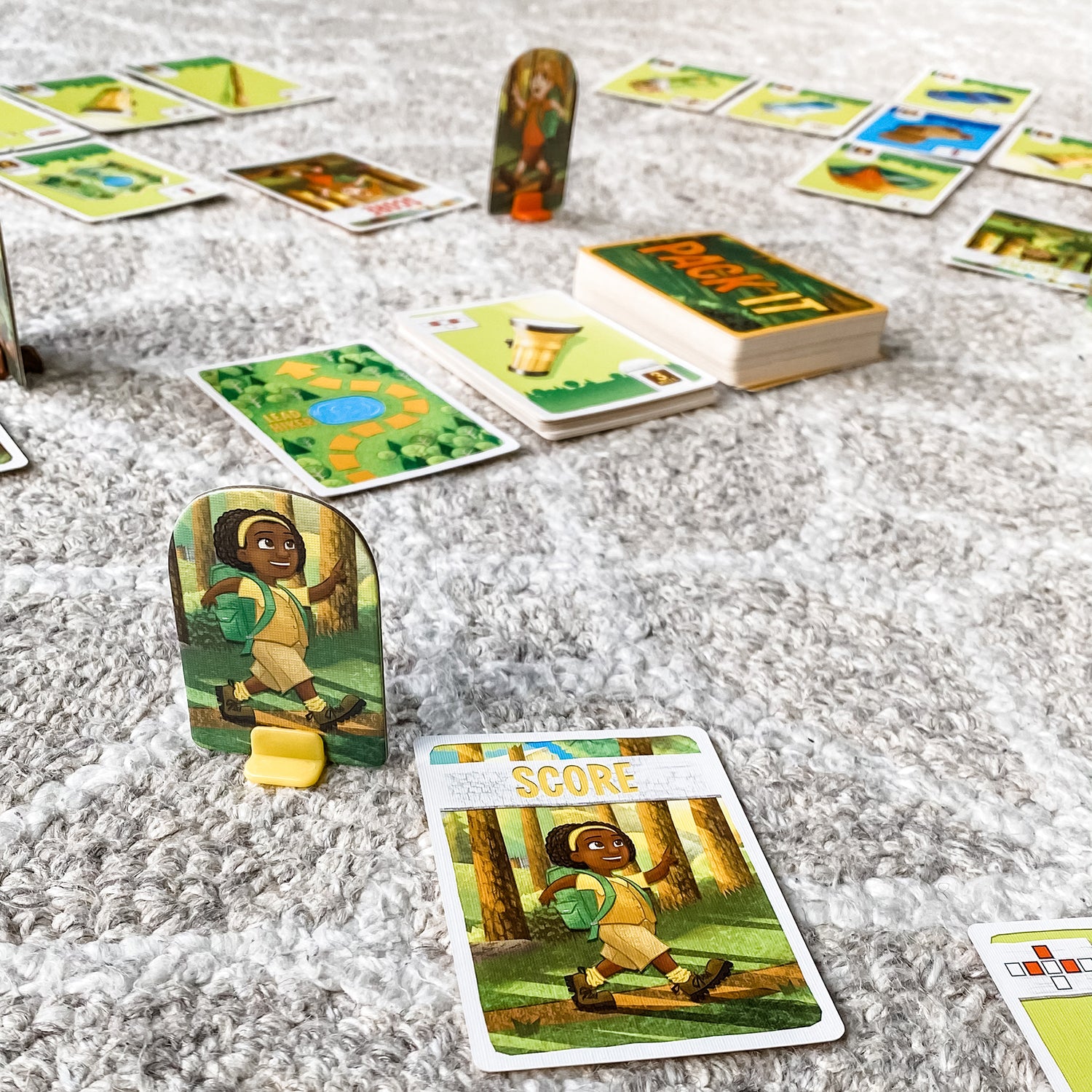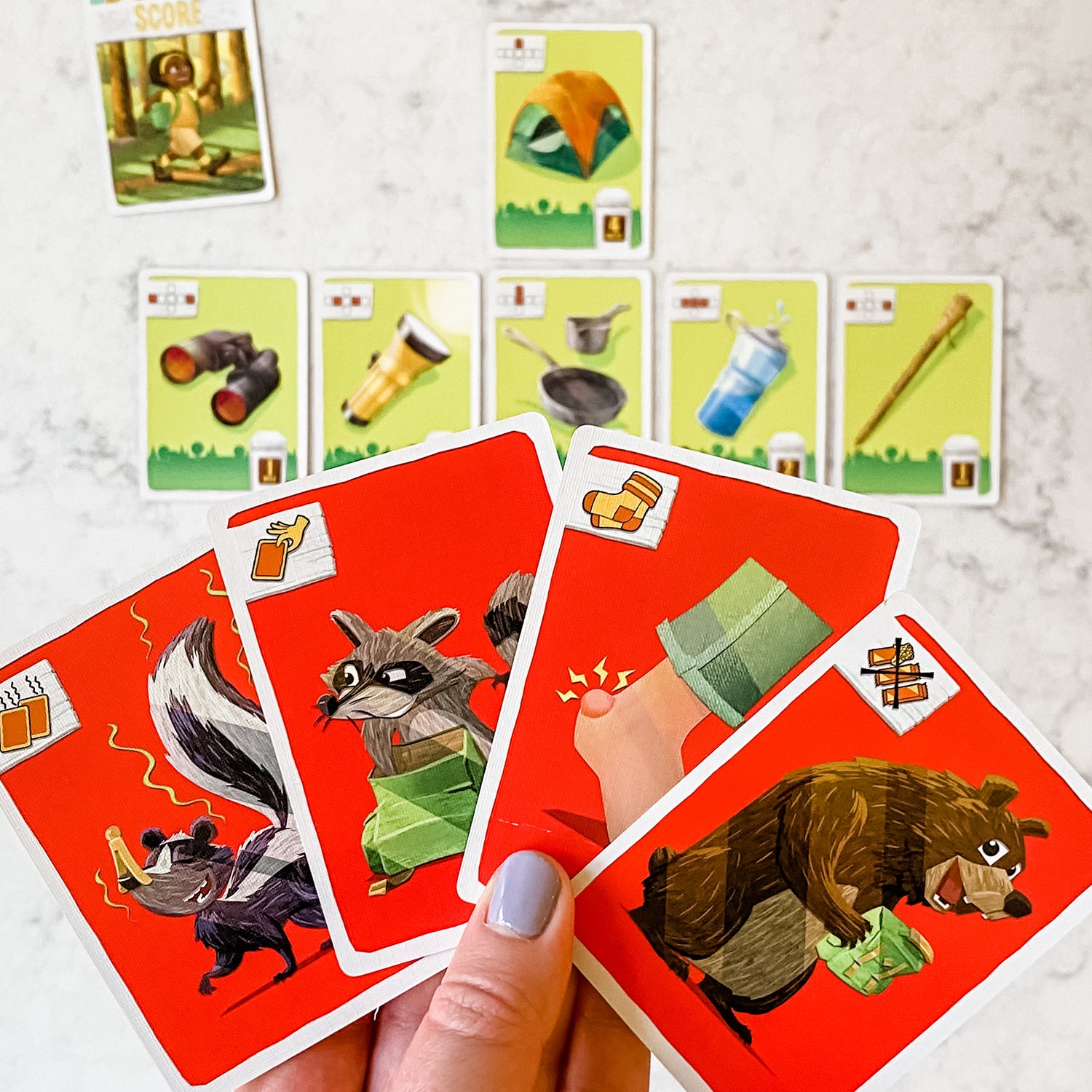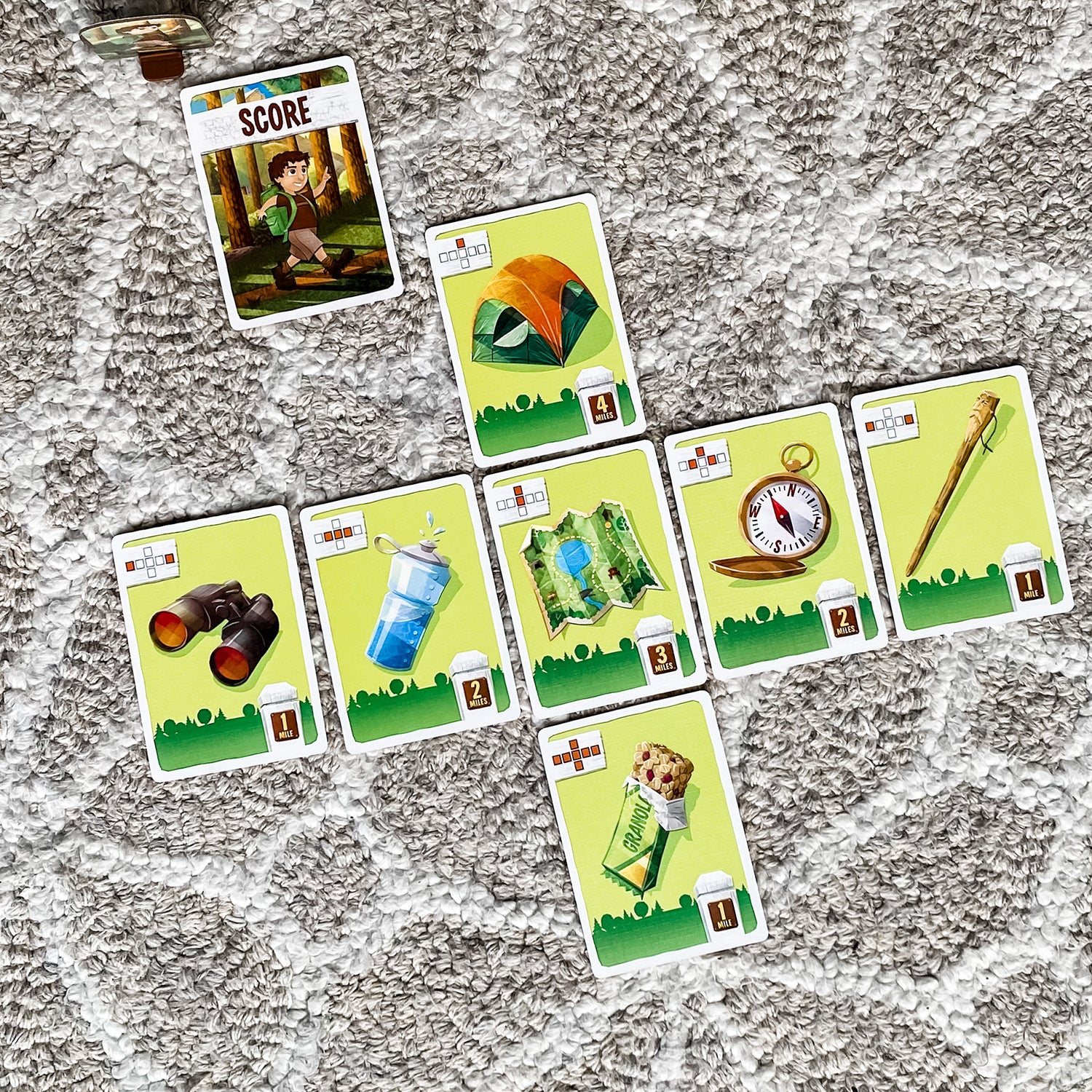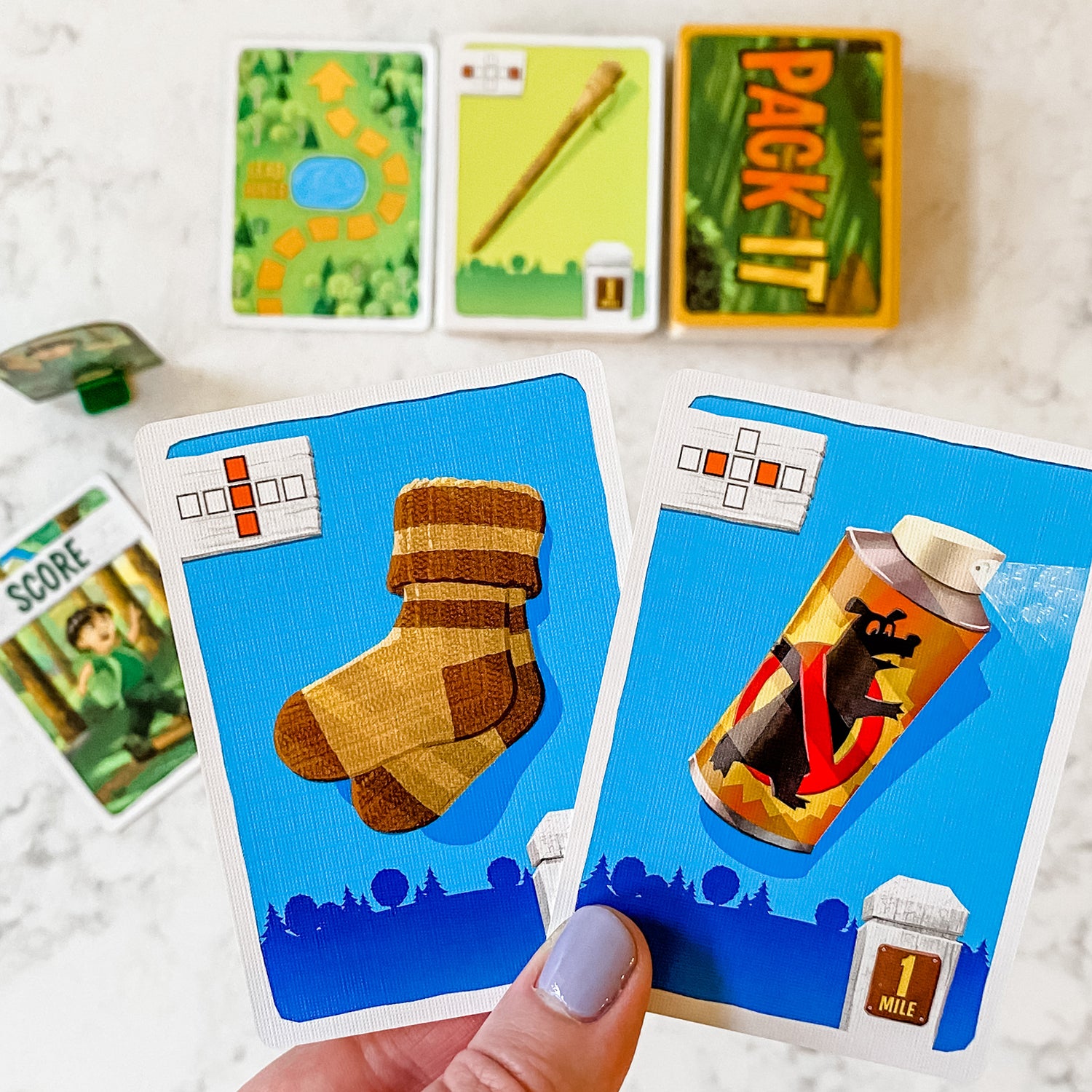Pack It
Pack It
2-5 players • 30 min • 8 & up
Focus: Predicting
Couldn't load pickup availability
Flex your prediction, planning and strategy skills to pack your backpack, keep precious supplies and stay on the hiking trail.
Skills: Predicting, Planning, Strategy
Game Includes
Game Includes
- 102 Pack It Cards
- 5 Scoring Cards
- 1 Lead Hiker Card
- 5 Player Pawns
- 5 Pawn Holders
- 1 Rules Booklet
Share
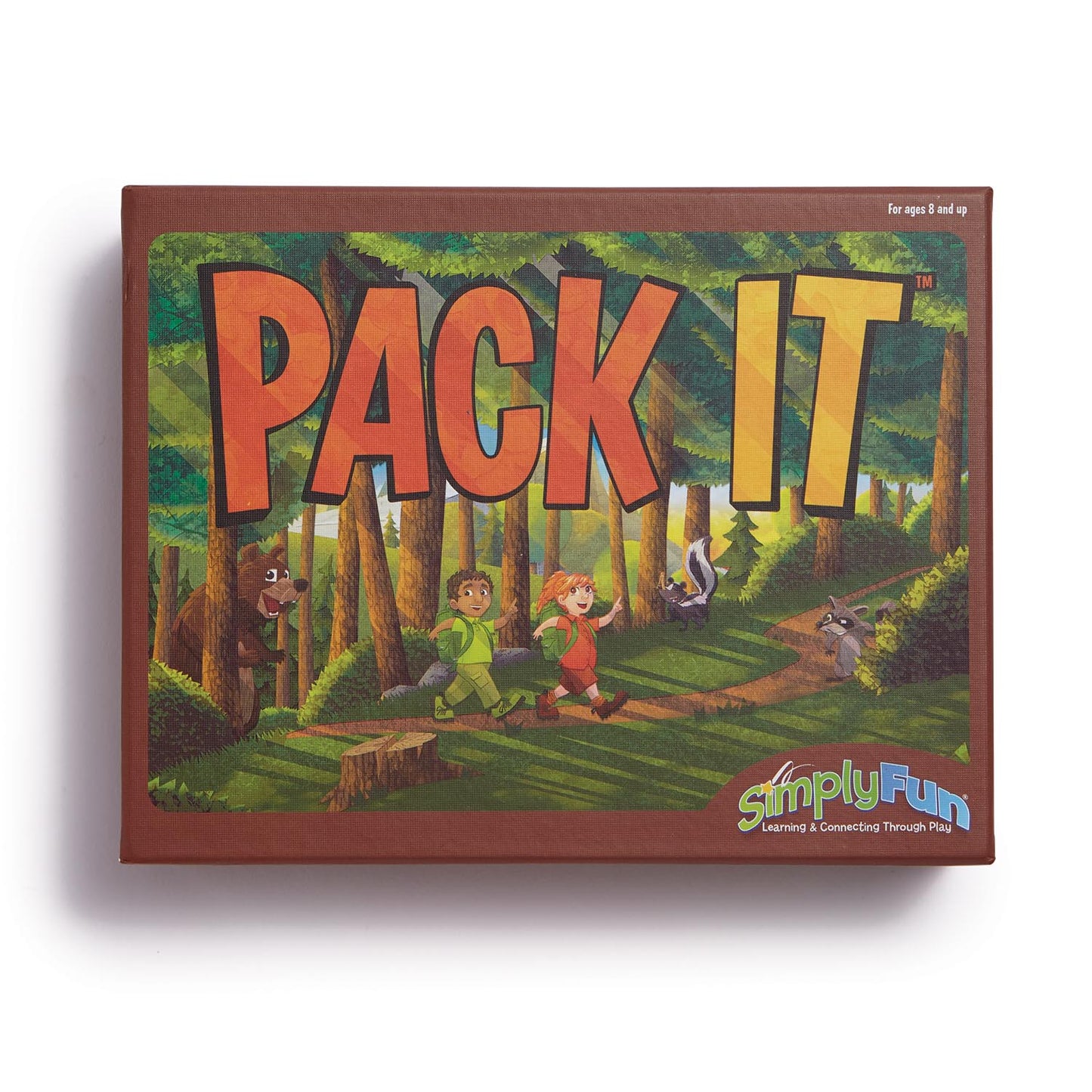
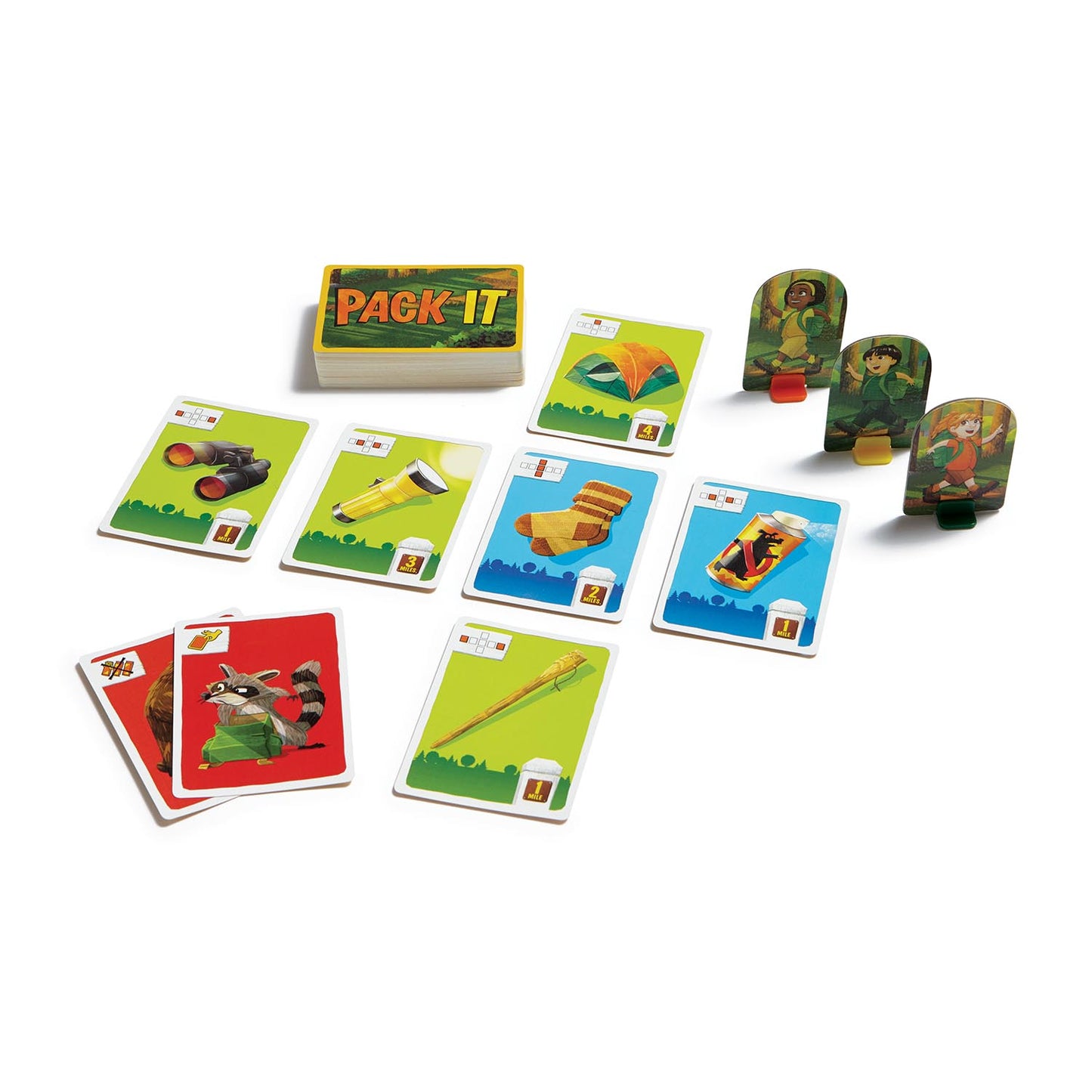
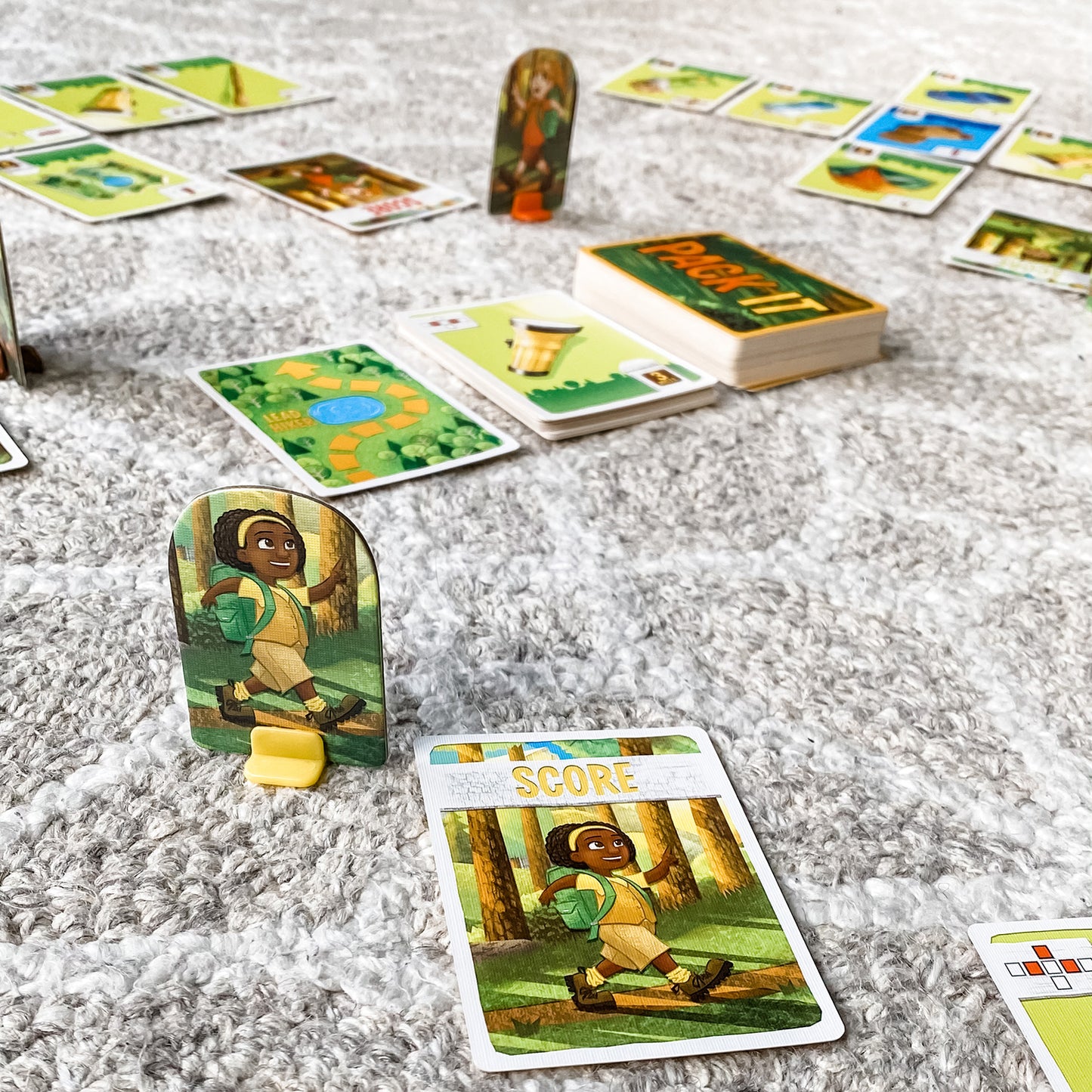
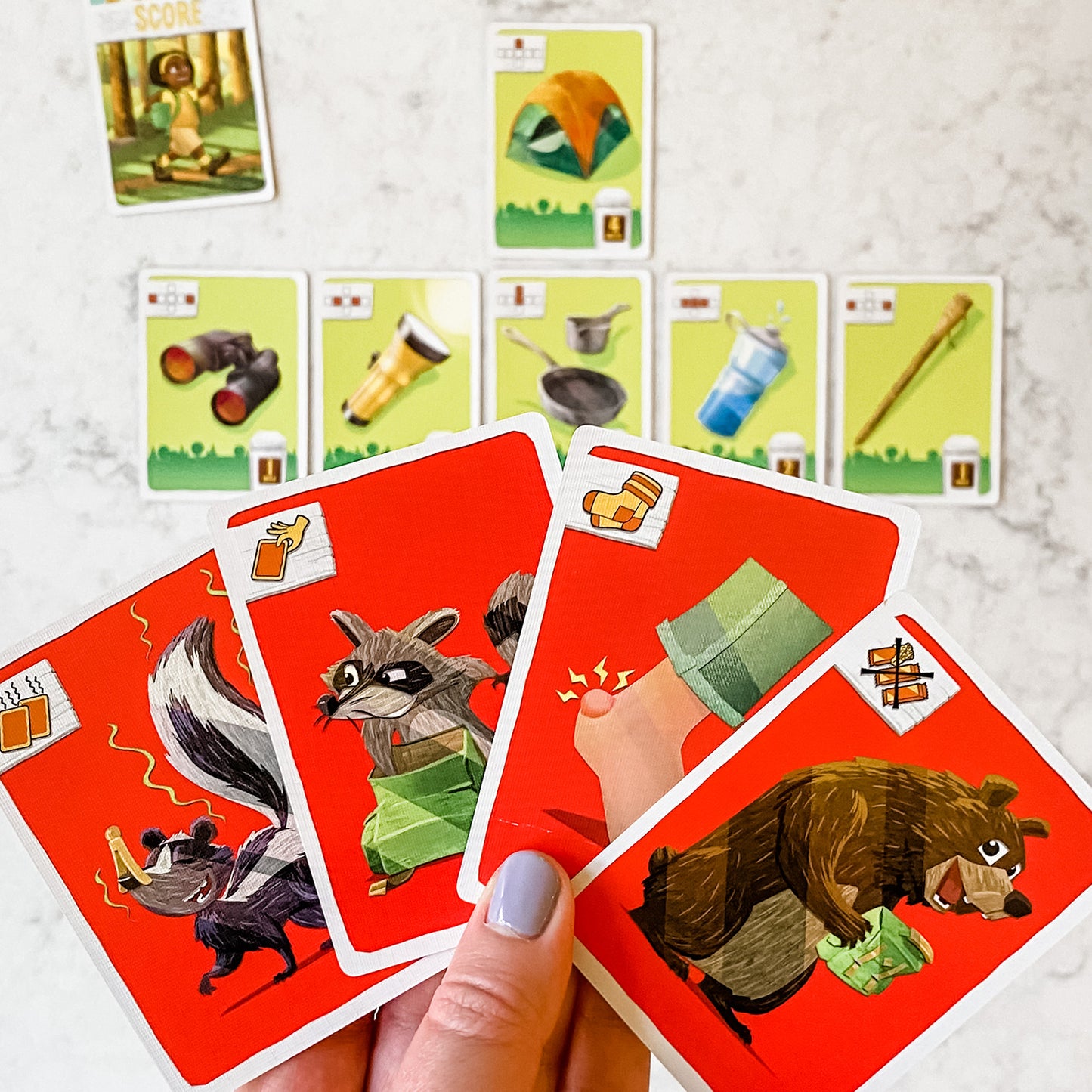
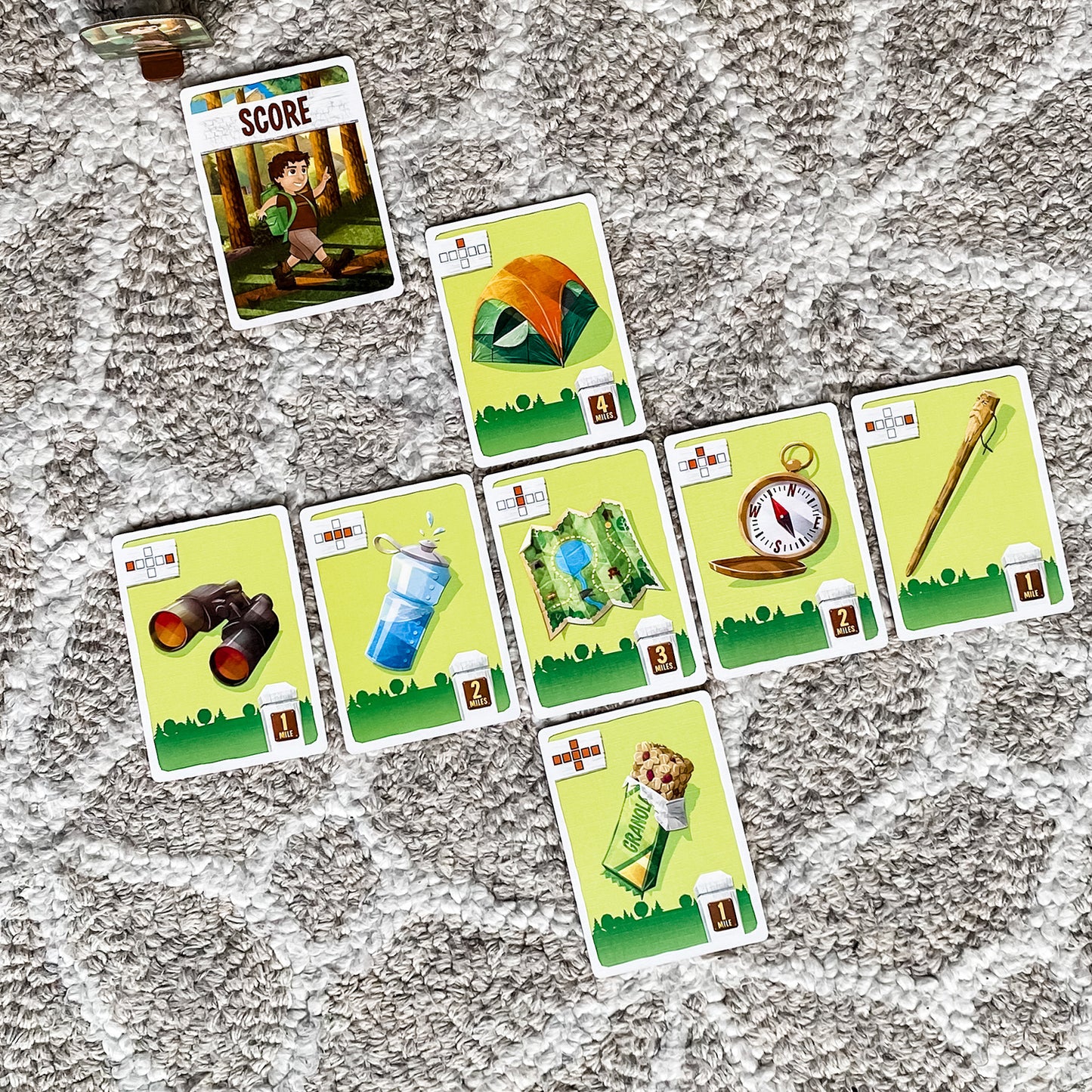
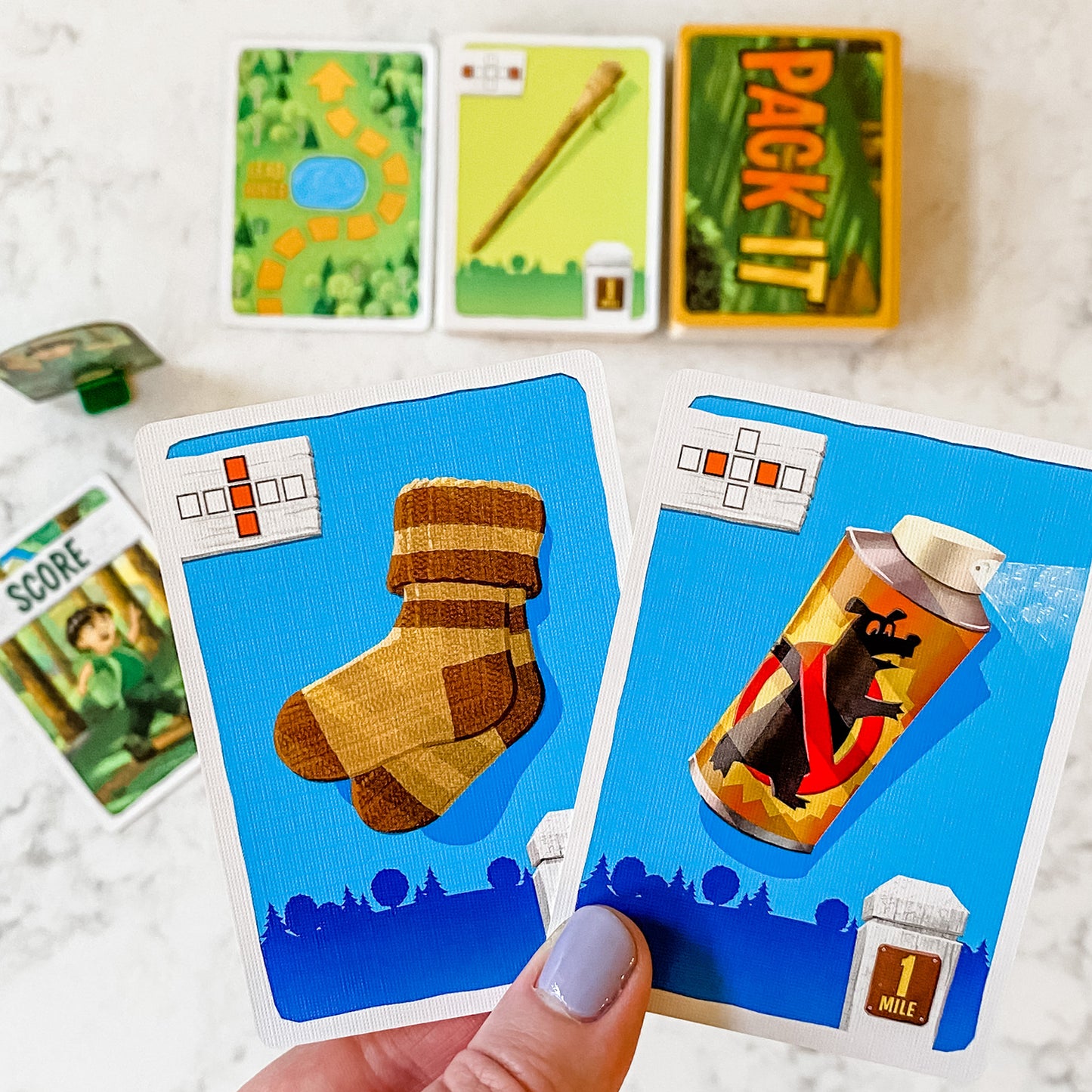

Collapsible content
How to Play
Educational Standards
Core Standard*: None
Skills
Explore
What Does Child Do To Use Skill In The Game?
Players look at their and other player's backpack cards, as well as the Hiking Pile.
How Parents Can Assist Learning
When children are learning the game, remind them that Sock and Bear Spray cards can be used as a defense to certain Hazard cards.
Learning Implications and Educator Support
When children are learning the game, remind them that Sock and Bear Spray cards can be used as a defense to certain Hazard cards.
Determine
What Does Child Do To Use Skill In The Game?
Players need to determine whether to start or join a hike, to leave a hike, where to place Item Cards and what to do when a card is turned over on to the Hike Pile.
How Parents Can Assist Learning
When children are trying to decide how to score, parents can remind children that they will likely need to lose some of the cards from their backpack in order to score points from the Hike Pile.
Learning Implications and Educator Support
Pack It scoring involves multiple step decision-making. First, a child needs to determine whether to start or join a hike, and then when to leave a hike with an opportunity to score. Educators can remind children that they will likely need to lose some of the cards from their backpack in order to score points from the Hike Pile. Placing the Item Cards involves visual spatial learning. Remind children that they can move cards around in their backpack to try to open a space for a new Item Card.
Compare
What Does Child Do To Use Skill In The Game?
If on a hike, players will compare the images and point values on their backpack cards with those of the top card on the Hike Pile. All players need to compare the possible locations an Item card can be located based on the Backpack Diagram with the actual spots available in their backpack.
How Parents Can Assist Learning
If a child needs to discard Item Cards, encourage them to stop and think before selecting which card(s) to discard. This can help the child consider all options and reduce impulsivity. When a children select an Item Card, remind them that they can rearrange their backpack to open a space for the new Item Card, if needed.
Learning Implications and Educator Support
If a child needs to discard Item Cards, encourage them to stop and think before selecting which card(s) to discard. This can help the child consider all options and reduce impulsivity. Also, comparing may involve some simple math as a child can add several cards together to equal the value of the Hike Card that has been turned face up. When a children select an Item Card, remind them that they can rearrange their backpack to open a space for the new Item Card, if needed.
Remember
What Does Child Do To Use Skill In The Game?
If a player selects a Sock or a Bear Spray, they need to remember that those cards can defend against the Blister and Bear Hazards.
How Parents Can Assist Learning
When children are learning the game, remind them that Sock and Bear Spray cards can be used as a defense to certain Hazard cards.
Learning Implications and Educator Support
When children are learning the game, remind them that Sock and Bear Spray cards can be used as a defense to certain Hazard cards.
Predict
What Does Child Do To Use Skill In The Game?
Players may try to predict when opponents will start a hike, would be likely to join a hike, or are preparing to leave a hike to score points.
How Parents Can Assist Learning
To be successful in Pack It requires thinking about consequences beyond a player's immediate move. For example, when on a hike, they need to look at the backpacks of other players. If their backpacks are getting low on cards, they may be likely to leave the hike and take a Hike Card. This type of long-term, sequential thinking is important for planning (establishing a sequence of logic steps towards a goal) and for prediction (anticipating possible outcomes or actions of others in order to make the best choice now).
Learning Implications and Educator Support
To be successful in Pack It requires thinking about consequences beyond a player's immediate move. For example, when on a hike, they need to look at the backpacks of other players. If their backpacks are getting low on cards, they may be likely to leave the hike and take a Hike Card. This type of long-term, sequential thinking is important for planning (establishing a sequence of logic steps towards a goal) and for prediction (anticipating possible outcomes or actions of others in order to make the best choice now).
Plan
What Does Child Do To Use Skill In The Game?
As play continues, players need to think about when they will start a hike.
How Parents Can Assist Learning
Planning is an important skill for developing strategic thinking. In this game, children begin to learn risk-reward evaluations that will influence their ultimate strategy. Ask children, "Do you think it would be better to start a hike now, or pick an Item card?" Discuss the trade-offs of either option, including comparing their cards to their opponents and thinking about how many points all of the players have accumulated so far. Talking aloud will also help with impulsivity, as children are engaging in more thorough analysis of their options and possible consequences.
Learning Implications and Educator Support
Planning is an important skill for developing strategic thinking. In this game, children begin to learn risk-reward evaluations that will influence their ultimate strategy. Ask children, "Do you think it would be better to start a hike now, or pick an Item card?" Discuss the trade-offs of either option, including comparing their cards to their opponents and thinking about how many points all of the players have accumulated so far. Talking aloud will also help with impulsivity, as children are engaging in more thorough analysis of their options and possible consequences.
Solve
What Does Child Do To Use Skill In The Game?
As Item and Hazard cards are selected, turned over on the Hike Pile and discarded, the elements of the game continuously changes. Thus, scoring requires responding to the evolving changes and actions of opponents.
How Parents Can Assist Learning
Children will need to make successful risk/reward assessments in order to win Pack It. Ask children, "Do you think it would be better to start a hike now, or pick an Item card?" Discuss the trade-offs of either option, including comparing their cards to their opponents and thinking about how many points all of the players have accumulated so far.
Learning Implications and Educator Support
Children will need to make successful risk/reward assessments in order to win Pack It. Ask children, "Do you think it would be better to start a hike now, or pick an Item card?" Discuss the trade-offs of either option, including comparing their cards to their opponents and thinking about how many points all of the players have accumulated so far.
Review
What Does Child Do To Use Skill In The Game?
Players need to review their cards at the end to determine who scored the most points.
How Parents Can Assist Learning
No special parent support required.
Learning Implications and Educator Support
No special parent support required.
*Data compiled from CCSSI ELA Standards, WA Science Standards, and Washington Social Studies Standards
Special Needs
Cognitive
Suggestions for How to Modify Play Experience
This game may be too challenging for children with cognitive delays.
Communication
Suggestions for How to Modify Play Experience
No communication is needed, but the child must comprehend the directions of the game and be able to pay attention to other players moves. When learning the game, demonstrate the different steps in the game one-by-one and make the goal of the game is understood.
Encourage players to make up stories about a camping trip and share them during their turn. For example, when a player draws a hazard card, they can avoid forfeiting cards and/or earn a bonus point if they can tell a story about how they overcame the hazard by using one of the items in their backpack.
Sensorimotor
Suggestions for How to Modify Play Experience
Not recommended for children with sensorimotor issues. There are many motor aspects of the game, such as ordering cards, drawing and placing cards, and moving a token.
Social Emotional/Behavioral
Suggestions for How to Modify Play Experience
Players who are not on a hike have to wait until the hike is over to play again. This may be difficult for children who have emotional or behavioral concerns. Not recommended for children with ADHD.
Children who have impulsivity or difficulty waiting will be inclined to always choose to hike and may all lose cards quickly. It may be frustrating for them if they lose cards and don't earn points. Not recommended for these children.
Vision
Suggestions for How to Modify Play Experience
This game is not recommended for visually impaired children. Cards have small symbolic print and numbers, and recognizing picture matches may be difficult for some.
Hearing
Suggestions for How to Modify Play Experience
Hearing impaired can play the game with gestures and/or signs.
*Data compiled from CCSSI ELA Standards, WA Science Standards, and Washington Social Studies Standards
Autism
Autism Special Considerations
Appears to ignore other's communication and/or has difficulty giving eye contact to a communication partner
Is This Game Appropriate for Child with Characteristic? No
Can Child with Characteristic Play Game w/o Modification? No
Strategies for Developing Compensatory Skills:
Attention to others' play is needed in the game.
Has difficulty understanding complex verbal directions
Is This Game Appropriate for Child with Characteristic? No
Can Child with Characteristic Play Game w/o Modification? No
Strategies for Developing Compensatory Skills:
Directions for play and earning points may be difficult for children with autism to understand.
Uses vocabulary inaccurately or demonstrates echolalia (repeating another's speech)
Is This Game Appropriate for Child with Characteristic? No
Can Child with Characteristic Play Game w/o Modification? No
Strategies for Developing Compensatory Skills:
Players need to discuss the game items, turns, and plans.
Gets stuck repeating a verbal topic or physical actions and/or has difficulty attending to others' actions or topic.
Is This Game Appropriate for Child with Characteristic? No
Can Child with Characteristic Play Game w/o Modification? No
Strategies for Developing Compensatory Skills:
Players need to attend to other player's comments.
Has difficulty producing speech/communication
Is This Game Appropriate for Child with Characteristic? Yes
Can Child with Characteristic Play Game w/o Modification? Yes
Strategies for Developing Compensatory Skills:
No communication is needed, but children need to discuss their intentions (hike, drop out of hike)
Has difficulty sequencing multi-step actions and/or doing complex abstract tasks
Is This Game Appropriate for Child with Characteristic? No
Can Child with Characteristic Play Game w/o Modification? No
Strategies for Developing Compensatory Skills:
Players need to make choices on their turns about what approach to take and then, if on a hike, make strategic decisions for each turn.
Demonstrates difficulty initiating and maintaining social interactions
Is This Game Appropriate for Child with Characteristic? Yes
Can Child with Characteristic Play Game w/o Modification? Yes
Strategies for Developing Compensatory Skills:
Social interaction is minimal, but players need to attend to each other's play.
Acts out or demonstrates avoidance behaviors when frustrated, overwhelmed, or needs more sensory input.
Is This Game Appropriate for Child with Characteristic? Yes
Can Child with Characteristic Play Game w/o Modification? No
Strategies for Developing Compensatory Skills:
Pack It may be difficult for children who get easily frustrated when they need to wait or do not get immediate reinforcement.
Has short attention span for non-preferred activities
Is This Game Appropriate for Child with Characteristic? Yes
Can Child with Characteristic Play Game w/o Modification? No
Strategies for Developing Compensatory Skills:
Pack It may not appeal to the child with autism unless camping is a preferred theme.
Needs sameness or consistent routines and/or has difficulty with transitions from one activity to another
Is This Game Appropriate for Child with Characteristic? No
Can Child with Characteristic Play Game w/o Modification? No
Strategies for Developing Compensatory Skills:
The game play in Pack It changes with each player's turn, so this may not appeal to children who like consistent rules and play behaviors.
Has difficulty understanding others' feelings, intentions, and the reasons for others' actions.
Is This Game Appropriate for Child with Characteristic? No
Can Child with Characteristic Play Game w/o Modification? No
Strategies for Developing Compensatory Skills:
Players must pay attention to others' intentions and strategies.
*Data compiled from CCSSI ELA Standards, WA Science Standards, and Washington Social Studies Standards
Extended Play
Extra Ways to Play the Game
Backpack items can be made into a memory game. Turn over all the cards. On their turn, a player turns over 2 cards. If they match, the player takes the pair. If not, turn them over and play passes to the left. The player with the most pairs at the end is the winner.
Materials Needed
No additional materials needed.
Developmental Benefits
Children like the idea of camping, and this easier modification may be motivating for the developmentally younger child.
Extra Ways to Play the Game
Make the game into a storytelling game. When players go on a hike, they take turns turning over a card. Anyone who has a match for the card in their backpack, tells a story about how the item was used on their hike. Whoever tells the best story (based on a vote by all players) takes the card and the points.
Materials Needed
No additional materials needed.
Developmental Benefits
Storytelling develops narrative skills needed for developing higher levels of literacy. Storytelling is also a means for encouraging creative thinking processes.
*Data compiled from CCSSI ELA Standards, WA Science Standards, and Washington Social Studies Standards
Collapsible content
How to Play Video & Transcript
Today, we’re going on a hike, so get your back pack ready and let’s learn how to play Pack It.
Pack It is great game for 2 to 5 players, ages 8 and up.
Every game box of Pack It, is “packed” with one hundred and two Pack It cards, including 90 Green and Blue Item cards…
…and 12 red hazard cards.
You’ll also find one Lead Hiker card…
five Scoring Cards….
…and five player pawns with holders to keep them on their feet.
Like with any hike, planning and preparation are important to be ready for what you might meet on the trail (including a hungry bear)! So deciding if you are prepared to go on a hike or should pass is an important decision to make. Kids and adults have the opportunity to practice these decision making skills numerous times during game play.
To set up the game, place the lead hiker card near the middle of the play area within reach of all players. Give each player a scoring card and a matching player pawn.
Shuffle the Pack It card deck and deal five cards to each player. The card deck is made up of all the green and blue item cards as well as all the red hazard cards.
Place the shuffled deck face down in the middle of the play area as the draw pile, leaving space for a discard pile AND a hiking pile, as shown.
Make sure to place discarded cards in the discard pile, not the draw or hiking piles.
Now, all players create their own Backpacks by placing their cards face up in front of them, in order according to the orange icons in the upper left corner of the cards, like this (show backpack set up diagram)
Next, any red hazard cards dealt to players must be discarded, and then replaced one for one with blue or green Item cards. Any cards that cannot fit in a player’s backpack must also be discarded so no cards remain in the players’ hands.
For example, there is no room for two tents or two maps and a frying pan in your pack!
Once all the backpacks are set up, reshuffle the discard pile into the draw pile.
The game begins first player doing one of two things: either draws a card… OR takes a hike.
If he chooses to draw a card, he takes ONE card from the draw pile. If it’s an ITEM card, he can put it in his backpack immediately as long as there is room, , rearranging cards if necessary to fit all the items, OR discarding an item card if everything doesn’t fit.
If a player draws a red hazard card – one that shows a Raccoon, a Skunk or a Blister – the player must perform the action on the card immediately.
However, If it’s the BEAR card, ALL players are affected by the bear’s action.
Once these actions are complete on a card-draw turn, the next player takes a turn.
Now, if a player chooses to take a hike instead of drawing a card, he places his pawn on the lead hiker card. Any players that wish to join the hike MUST place their pawns behind the lead hiker (as shown).
The lead hiker then draws a card from the draw pile and places it on the hiking pile, and ALL players must resolve the card at that time. That means that each player on the hike must match the card drawn with a like card from their back pack. If they match, then they are safe. A hiker without a match must discard one or more cards of equal or higher value into the discard pile.
Once all players on the hike have resolved the current hiking card, then may then decide to continue hiking or to drop out. If they choose to drop out, they may collect one of the Item cards (if available) from the hiking pile to count for their final score. We’ll talk about scoring in a moment.
The hike continues until all players have dropped out, and then play resumes with the next player’s turn.
Card collected on the hike for scoring are placed under the player’s scoring card, not in their backpacks, and the final hiker to drop out gets to collect all the remaining cards in the hiking pile to add to their score pile.
The game ends immediately after all the cards have been drawn from the draw pile. If this occurs during a hike, someone must reshuffle the discard pile to make a new deck and complete the hike. At that point, the game ends when the hike is over.
To determine the winner at the end of the game, each player counts the miles shown in the lower right corner of the cards in their SCORING pile. Cards that are still in players’ backpacks don’t count for the score.
Once tallied, the player who has traveled the most miles wins!
Rain or shine, your hike is ready and waiting so get busy, fill up your pack and venture out on a hike. But be prepared for bears, skunks, raccoons and the occasional blister before you Pack It up!

